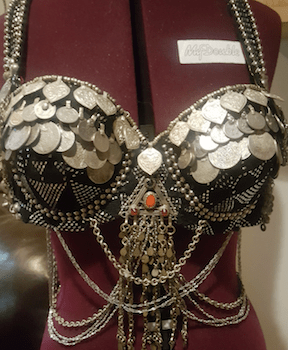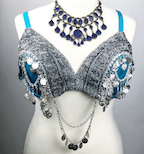Today I ran across a fabulous bra-making tutorial on the Assiut Group on Facebook. I really enjoyed her tutorial, and I thought it would be great to make a list of a few other of my favorite bra tutorials from around the web. If you are looking to create a masterpiece from Assiut, or if you are more sparkle and glam, there are many different styles to choose from in this collection.
Brick House Designs – Assiut Bra Resize
When I saw this blog post shared on the Facebook assiut group, I immediately went over to take a look! Not only is this tribal bra full of crusty coin and chain goodness, it has some beautiful assiut base cloth. Her mission was to take a larger cup size down to a smaller size is a fairly common alteration in my studio, and it’s nice to see how another designer tackles the project.
Jo has a great eye, not only for the design of this costume piece but also for the step-by-step photos that she shares in this post. I particularly love that Jo has chosen to share how she’s pieced the design together from fountain motifs. She really maximized the number of silver embroidery stitches would show beneath the rows of coins. Be sure to watch her video on a portable device to get the full effect!
Jo, many thanks for the shout-out for my book too! That made my day!
Joanna Dyndor – Tribal Belly Dance Bra out of Recycled Materials
Are you making a tribal fusion style of bra using recycled, upcycled, and repurposed materials? Then this is a vlog for you! This lovely costume piece is by Joanna Dyndor. Her video follows her process of using a heavily embroidered ribbon scrap, a handful of beads, ruched fabric, and repurposed chain. The result is a lovely performance bra in shades of brown, tan, and cream.
 Hanaan Tribal – Tribal Bra Tutorial
Hanaan Tribal – Tribal Bra Tutorial
This blog post steps through the process of taking making a halter style top with tie back. This assiut bra elegantly uses a basic silver-dotted fabric accentuated with coins and gilets.
One of the common problems for dancers looking for new costumes is the lack of options at larger bra sizes. If you are a dancer who can’t find bras for bigger curvier women, this is a great example of how a lingerie bra can be transformed for more zaftig physiques.
Shushanna Designs – How to Cover a Bra
This illustrated costuming tutorial walks the reader through how to cover a basic belly dance bra using Shushanna’s technique. Virtually every lingerie style bra needs to be covered before it’s embellished and this method really works. If you learn best from step-by-step illustrations this blog is not to be missed!
Sparkly Belly – Ultimate Bra Tutorial
Mao has created a great free resource for dancers interested in creating their own glam-style belly dance costume bras. There are many more free and paid tutorials, demos and classes available on her site. So if you are more sequins and stones, rather than coins and chain, than this website is a great resource.
Studio Davina – Bra Tutorials

Of course, over time I’ve put up a few bra demos/tutorials as well. Here are a few featured here in past blog posts:
Student Grade Belly Dance Bra – Need a cheap and cheerful costume for a student performance? Need the costume fast and affordable? This is the style of bra I teach in classes for students who need a “one-shot” bra suitable for performance with a minimum investment. The key? Start with a lingerie bra the color you want and simply embellish the cups! Read more details.
 Designing a Lavender Bedlah Ensemble – Although this four-part tutorial is for a bra and belt set, the bulk of the images and directions are about the bra. There are a lot
Designing a Lavender Bedlah Ensemble – Although this four-part tutorial is for a bra and belt set, the bulk of the images and directions are about the bra. There are a lot
I constructed this bedlah set using more hard-style professional techniques for the bra and belt. This is a very different approach from the student grade costume in the post above. It’s nice to have some different approaches to reach for that accommodate different budgets and timelines. Read more details.

Three Day Assiut Challenge – When I was working on the build for the book “The Cloth of Egypt” I made this costume for a last minute show. I wanted to promote my upcoming book, and yet, I didn’t have an assiut costume that fit! So I took my sewing kit with me on the trip and made the costume in the days leading up to the show. While this wasn’t my first assiut bra, it was the first made for the book! Read more details.

 Embellished Bras – The book
Embellished Bras – The book
Of course, If you want to read the book that accompanies my basic bra building class, it’s available on both Amazon and on Etsy (if you want a signed copy)
If you already own a copy of my Embellished Bras book, thank you very much for supporting my business! But I really believe in the motto, “There’s more than ONE way to do it the RIGHT way!” It’s always nice to explore the internet looking for new tips, tools, and techniques. I’m always open to learning new methods, especially if they save time and/or money!
If you find any wonderful resources, be sure to let me know. The best way to share costuming information is either by joining me in the Studio Davina Facebook group, or you can drop me a line via email – davina@davina.us.
Happy Costuming!
Dawn Devine ~ Davina
April 16, 2018

















 The Language of Wedding Shawls
The Language of Wedding Shawls



